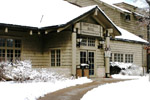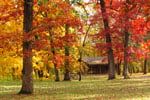MATTHIESSEN STATE PARK
Canyons, streams, prairie and forest combine to delight visitors at Matthiessen State Park. Located in central LaSalle County, approximately four miles south of Utica and three miles east of Oglesby, Matthiessen is a paradise for those interested in geology as well as recreation. Visitors can expect to see beautiful rock formations in addition to unusual and abundant vegetation and wildlife. All of this, along with park and picnic facilities, make Matthiessen State Park a popular choice for a special outing.
Geological Features:
The many unusual and beautiful rock formations make a trip to Matthiessen State Park an educational as well as a fun experience. Exposed sandstone can be seen throughout. The main canyon, consisting of the Upper and Lower Dells, provides an unusual and interesting walking tour. The Upper Dell begins at Deer Park Lake and continues to Cascade Falls, where the canyon drops 45 feet and the Lower Dell begins. The canyon, formed by water erosion, is approximately one mile long, from Deer Park Lake to the Vermilion River. Visitors may observe ground water seeping out along the sandstone of the canyon walls. As the ground water evaporates along the canyon walls, the minerals that are carried in solution in the water contribute to the beautiful coloring of the rocks.
The park has several mineral springs, and each was a popular spot for the large deer population that used it as a salt lick.
Flora and Fauna:
Visitors will delight at the abundance of plant and animal life. The park is alive with common and uncommon species of flora and fauna. The canyon provides a perfect habitat for many mosses and liverworts which thrive on the damp shady walls. Ferns also grow in the rich soil. Other vegetation in the canyon interior is limited to the simpler or lower orders of plant life, because most plants cannot take root on the steep rock walls. Cliff swallows and rock doves may be seen perching on the canyon walls, while frogs, toads and salamanders seek out the cool, moist canyon floors.
Along the dry, sandy bluff tops near the canyon edge, black oak, red cedar and white oak grow in abundance. White pines and white cedar are also found here, carried south by the glaciers of long ago. Shrubs common to this area include serviceberry and northern honeysuckle. Scarlet tanagers and cedar waxwings can be seen feeding on the berries of these shrubs. Holes made by yellow-bellied sapsuckers can be found on the cedar trees, as these birds feed on the sap and small insects located there. In the spring, beautiful magenta-colored blossoms erupt on the shooting star plants and the bright orange of the columbine delights the eye. By summertime, a rainbow of color emerges with the yellow partridge pea, the violet spiked lead plants and purple square-stemmed mint plants.
Farther back from the bluffs, bur oak and hickory grow. At the foot of these trees grow American witch hazel, black huckleberry and bracken fern. Nuthatches and chickadees can be seen feeding on the nuts, seeds and insects here.
Jack-in-the-pulpits, pastel-colored hepatica and delicate pink spring beauties blossom in the shaded forest soil during the spring. In the area where the sun breaks through the trees, black-eyed Susans and pink, spiked tick-trefoils bloom through the summer. Raccoons and flying squirrels spend hours among the trees searching for and gathering berries and nuts.
Along the forest edges, bright blue indigo buntings fly among the wild crabapple and plum trees. Cottontail rabbits scamper through the bluestem and Indian grasses. Red-tailed hawks soar overhead searching for field mice. Three-leaved poison ivy plants are found in all areas of the park, growing both as a vine and as an individual woody plant. Its greenish-white berries are a prime source of food for the many birds residing here.
Matthiessen State Park was named for Frederick William Matthiessen, a prominent industrialist and philanthropist from LaSalle. He originally purchased the land near the end of the 19th Century and developed it as a privately owned park for many years. Mr. Matthiessen employed about 50 people to construct trails, bridges, stairways and check dams. The area was originally referred to as ?Deer Park,? in reference to the large deer population. The original 176-acre park consisted primarily of a long narrow canyon with a small stream flowing through it. At that time these formations were called ?dells,? a name that has stayed with the park. After Matthiessen?s death, the park was donated to the State of Illinois, which opened it as a public park. In 1943, the state renamed the park in honor of Matthiessen. Since then, the park has grown to 1,938 acres and includes much of the significant natural areas along the main dell, some former prairie land, and some forest land south of the original park.
An equestrian campground for horseback riders and their horses is located west of Route 178 between Route 71 and the Dells Area entrance.
The equestrian campground is for horseback riders only please. Sites are first come first serve and reservations cannot be made through the park or online. Campers will complete a registration envelope at the campground and drop the information and fee for the night in the box provided at the campground.

Hotels/Motels
Relax in the rustic beauty and comfort of Starved Rock Lodge, Cabins and Starved Rock Inn. The historic Lodge has 69 guest rooms, which include three bay-window rooms, plus cabins nestled in the woods. Fireplaces can be found in four of the eight sunset cabins near the pool area...
2.2 miles from park*

Cottages and Cabins
Within a 10 minute drive from Starved Rock and even closer to Matthiessen State Parks you will find a gorgeous, tranquil property with spacious cabins on 50 wooded acres. All with full kitchens and outdoor fire pits. 3 dog friendly.
6.1 miles from park*





